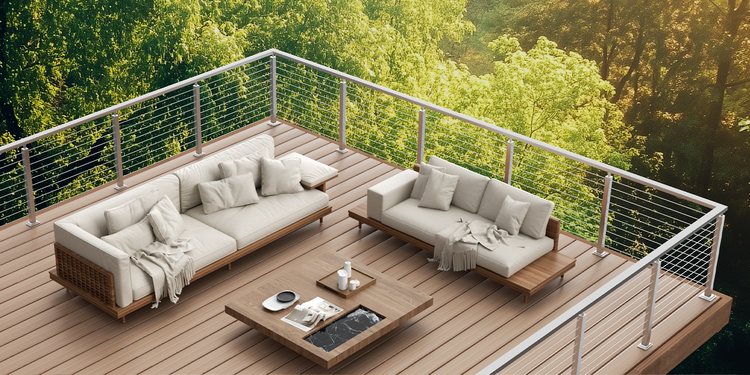Installing a cable railing system can enhance the aesthetics and safety of your home. These modern railing solutions are known for their sleek design and durability, making them a popular choice for both interior and exterior spaces. Cable railings provide an unobstructed view while maintaining safety, ideal for balconies, decks, and staircases. Whether you're a seasoned DIY enthusiast or a beginner, you'll find everything you need to transform your space with a cable railing system.

Tools and Materials You’ll Need:
- Cable railing system kit
- Drill and drill bits
- Screwdrivers
- Level
- Measuring tape
- Cable cutters
- Tensioning tool
- Safety goggles and gloves
It's important to select tools that are appropriate for the materials you've chosen for your cable railing. For example, working with metal may require different equipment than wood.
Step 1: Plan Your Installation
Before starting, measure the area where you plan to install the railing. Determine the number of posts required and the length of the cables. Ensure you comply with local building codes and safety regulations.
Standard heights are typically 36" residential and 42" commercial. For safety, codes require infill cables to prevent the passage of 4" spheres. Fulifix recommends 3" spacing between horizontal infill cables and post spacing to be between 3'-4'.

Step 2: Install the Posts
- Marking the exact positions for the posts on your deck or floor and use a power drill to create holes for the post bases.
(Select a drill bit that matches the size of your post screws, and be mindful of the depth to ensure a secure fit. )
- Position each post over its corresponding hole and use screws to secure them in place.
(Choose screws that are appropriate for the material of your deck or floor, whether it's wood, composite, or concrete.)
- To ensure the posts are perfectly vertical, use a spirit level. Double-check each post's stability and verticality, as any slight misalignment can affect the tension of the cables later on.
Take your time to verify that all posts are solidly installed before moving on to the next step in the installation process. This step is crucial for maintaining the safety and appearance of the railing system.

Step 3: Attach the Handrail
Handrail is a critical component of the cable railing system, providing both structural support and a guide for the cables.
- Measuring the distance between the end posts to ensure the handrail fits perfectly. Cut the handrail to the correct length if necessary, using a saw appropriate for the material. Double-check the measurements to avoid any gaps or misalignment.
- Using a spirit level, verify that the handrail is perfectly level from end to end. This step is crucial, as a level handrail ensures that the cables will be correctly tensioned and aligned later on. Make any necessary adjustments before permanently fastening the handrail.
Step 4: Thread and Tension the Cable
Stainless steel cables are the defining feature of your railing system, providing both safety and a sleek, modern appearance.
- Measure the length of each cable run between the end posts, allowing a few extra inches for adjustments and secure fastening.
- Thread cable through the pre-drilled holes in the posts, beginning at one end of the railing.
- Attach one end to the tensioning fittings at the starting post. Move to the opposite end of the cable run and repeat the attachment process. Use a tensioning tool or wrench to tighten the cable gradually. Start with a moderate tension and slowly increase it, ensuring the cable is taut but not overstretched.
- Use cable cutters to trim any excess cable at the ends. Ensure the cuts are clean and flush with the fittings to prevent sharp edges. Wearing safety gloves during this step is advisable to protect your hands from frayed cable ends.
Step 5: Secure the Cable and Inspect
Once all cables are threaded and tensioned, it's time to secure them and conduct a final inspection to ensure everything is correctly installed and safe for use.
- Secure the ends of each cable using the appropriate fittings included in your cable railing kit. These fittings are designed to lock the cables in place, preventing slippage and ensuring long-term stability.
- Test the stability of the posts and handrail, making sure there is no wobbling or movement when pressure is applied.
- Check that all cables are properly tensioned and that there is no slack or sagging in any part of the system.
- Walk along the length of the railing, applying gentle pressure to ensure it can withstand typical use without compromising its integrity.
- Visually inspect the entire installation to ensure it aligns with your aesthetic expectations. The cables should appear straight and evenly spaced, creating a clean and modern look that enhances your space.
Tips for a Successful Installation:
- Regularly check the alignment of posts and cables during installation.
- Wear safety gear to protect yourself from any potential hazards.
- If unsure about any steps, consult the instruction manual provided with your cable railing kit or seek professional advice.
By following these steps, you can install a cable railing system that not only enhances the look of your home but also provides safety and durability. Happy DIY-ing!
CTA: Ready to start your cable railing project? Purchase our cable railing system kits now.
Social Media Sharing:
Share your successful installation with us on Facebook and Twitter!

